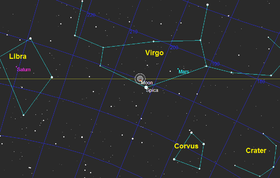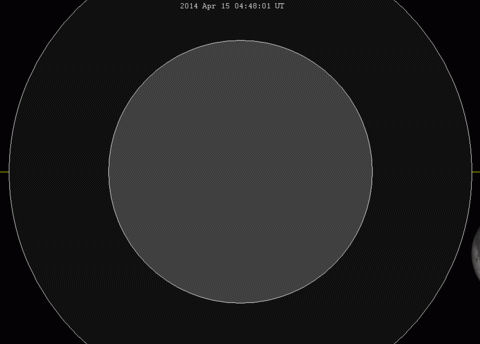WOW-We have a sky 'Happening' tonight! First of all, the April Full Moon is referred to as the Pink Moon in the Farmer's Almanac (as you will see below). Next, the moon becomes a Blood Moon as the full eclipse occurs. There is nothing to be afraid of and all info is below to bring you up to speed on the 4 eclipses in a row. I just checked outside and the moon is in the sky ready for the eclipse. Check your location and you may be able to see this event. Get your cameras out as this is somewhat of a rare occurrence. Your photostudy is of tonight's rising moon with Mars visible. Enjoy!
https://en.wikipedia.org/wiki/Full_moon
Full moon
From Wikipedia, the free encyclopedia
A full moon is the lunar phase that occurs when the moon is completely illuminated as seen from the earth. This occurs when the moon is in opposition with the sun (when it is on the opposite side of the Earth from the Sun; more precisely, when the ecliptic longitudes of the Sun and Moon differ by 180 degrees).[1] This means that the hemisphere of the Moon that is facing the Earth (the near side) is almost fully illuminated by the Sun and appears round (while the far side is almost completely unilluminated).
Lunar eclipses can occur only at full moon, where the moon's orbit allows it to pass through the Earth's shadow. Lunar eclipses do not occur every month because the moon usually passes above or below the Earth's shadow (which is mostly restricted to the ecliptic plane). Lunar eclipses can occur only when the full moon occurs near the two nodes of the orbit, either the ascending or descending node. This causes eclipses to only occur about every 6 months, and often 2 weeks before or after a solar eclipse atnew moon at the opposite node.
The time interval between similar lunar phases—the synodic month—averages about 29.53 days. Therefore, in those lunar calendars in which each month begins on the new moon, the full moon falls on either the 14th or 15th of the lunar month. Because calendar months have a whole number of days, lunar months may be either 29 or 30 days long.
The individual names given in Farmers' Almanac include:[clarification needed]
- January: "Wolf Moon" (this is the name of December in Beard 1918)[16] also "Old Moon"
- February: "Snow Moon", also "Hunger Moon"
- March: "Worm Moon", "Crow Moon", "Sap Moon", "Lenten Moon"
- April: "Seed Moon", "Pink Moon", "Sprouting Grass Moon", "Egg Moon" (c.f. "Goose-Egg" in Beard 1918), "Fish Moon"
- May: "Milk Moon", "Flower Moon", "Corn Planting Moon"
- June: "Mead Moon", "Strawberry Moon" (c.f. Beard 1918), "Rose Moon", "Thunder Moon"
- July: "Hay Moon", "Buck Moon", "Thunder Moon"
- August: "Corn Moon", "Sturgeon Moon", "Red Moon", "Green Corn Moon", "Grain Moon"
- September: "Harvest Moon", "Full Corn Moon",
- October: "Hunter's Moon", "Blood Moon"/"Sanguine Moon"
- November: "Beaver Moon", "Frosty Moon"
- December: "Oak Moon", "Cold Moon", "Long Nights Moon"






https://plus.google.com/u/0/photos/117645114459863049265/albums/6002368604780562497


https://en.wikipedia.org/wiki/April_2014_lunar_eclipse
April 2014 lunar eclipse
From Wikipedia, the free encyclopedia
A total lunar eclipse will take place on April 15, 2014. It will be the first of two total lunar eclipses in 2014, and the first of a tetrad (four total lunar eclipses in series). Subsequent eclipses in the tetrad will occur on October 8, 2014, April 4, 2015, and September 28, 2015.
The April 15 eclipse will be visible in the Pacific Ocean region, including Australia and New Zealand, as well as the Americas. The moon will pass south of the center of the Earth's shadow. As a result, the northern part of the moon will be noticeably darker than the southern part. It will occur during the ascending phase of the moon's orbit, part of lunar saros 122.
| Total lunar eclipse April 15, 2014 | |
|---|---|
 The moon passes right to left through the Earth's shadow | |
| Gamma | -0.3017 |
| Duration (hr:mn:sc) | |
| Totality | 1:17:48 |
| Partial | 3:34:43 |
| Penumbral | 5:43:54 |
| Contacts (UTC) | |
| P1 | 4:53:40 |
| U1 | 5:58:19 |
| U2 | 7:06:46 |
| Greatest | 7:46:48 |
| U3 | 8:24:34 |
| U4 | 9:33:02 |
| P4 | 10:37:33 |
 The lunar eclipse will occur in the constellation Virgo, near the star spica with the planet Mars near, slightly west on theecliptic. | |
Background[edit]
Main article: lunar eclipse
A lunar eclipse occurs when the moon passes within Earth's umbra (shadow). As the eclipse begins, the Earth's shadow first darkens the moon slightly. Then, the shadow begins to "cover" part of the moon, turning it a dark red-brown color (typically - the color can vary based on atmospheric conditions). The moon appears to be reddish due to Rayleigh scattering (the same effect that causes sunsets to appear reddish) and the refraction of that light by the Earth's atmosphere into its umbra. [1]
The following simulation shows the approximate appearance of the moon passing through the earth's shadow. The moon's brightness is exaggerated within the umbral shadow. The northern portion of the moon will be closest to the center of the shadow, making it darkest, and most red in appearance.

Description[edit]
On April 15, 2014, the moon will pass through the southern part of the Earth's umbral shadow.[2] It will be visible over most of the Western Hemisphere including east Australia, New Zealand, the Pacific ocean, and the Americas.[3] In the western Pacific, the first half of the eclipse will occur before moonrise. In Europe and Africa, the eclipse will begin just before moonset.[2] In North America, Mars will arguably be the most prominent object in the sky other than the moon, appearing 9.5° northwest of the moon.[3][2] Spica will be 2° to the west, while Arcturus will be 32° north. Saturnwill be 26° east and Antares 44° southeast.[2]
Mars will be at opposition on April 8 and closest to earth on April 14, so the eclipse will also be an excellent time to observe Mars in a good telescope. It will be a minimum distance of 0.618 AU, the closest approach since 2007. With an apparent diameter of 15.2", Mars will appear as large in 120 power telescope as the moon will with the unaided eye.[4][5]
The moon will enter Earth's penumbral shadow at 4:54 UTC and the umbral shadow at 5:58. Totality will last for 1 hour 18 minutes, from 7:07 to 8:25. The moment of greatest eclipse will occur at 7:47. At that point, the Moon's zenith will be approximately 3,000 kilometres (1,900 mi) southwest of the Galapagos Islands. The moon will leave the umbra shadow at 9:33 and the penumbra shadow at 10:38.[2]
The umbral magnitude will peak at 1.2907. At that moment, the northern part of the moon will pass 1.7 arc-minutes south of the center of Earth's shadow, while the southern part will be 40.0 arc-minutes from center. Thus, thive you an ideae northern part of the moon will be noticeably darker. The moon's appearance will change significantly throughout the eclipse as the depth of the shadow changes. The gamma of the eclipse will be -0.3017.[2]
The eclipse will be a member of Lunar Saros 122. It will be the 56th such eclipse.[2]
The following pics are the same as above. They have been treated with the 'Heat Map' effect in Picasa editing tools. It will show the detail of the moon and give you an idea of what the moon would look like in the shade of red!



https://plus.google.com/u/0/photos/117645114459863049265/albums/6002370903026976337






...this is brendasue signing off from Rainbow Creek. See You next time!



O+O



No comments:
Post a Comment
Hi Everybody! Please say hello and follow so I know you are here! Due to the inconsideration of people trying to put commercials on my blog comment area, I have restricted use of anonymous posts. Sorry that some hurt all.
My public email is katescabin@gmail.com No spammers or trolls